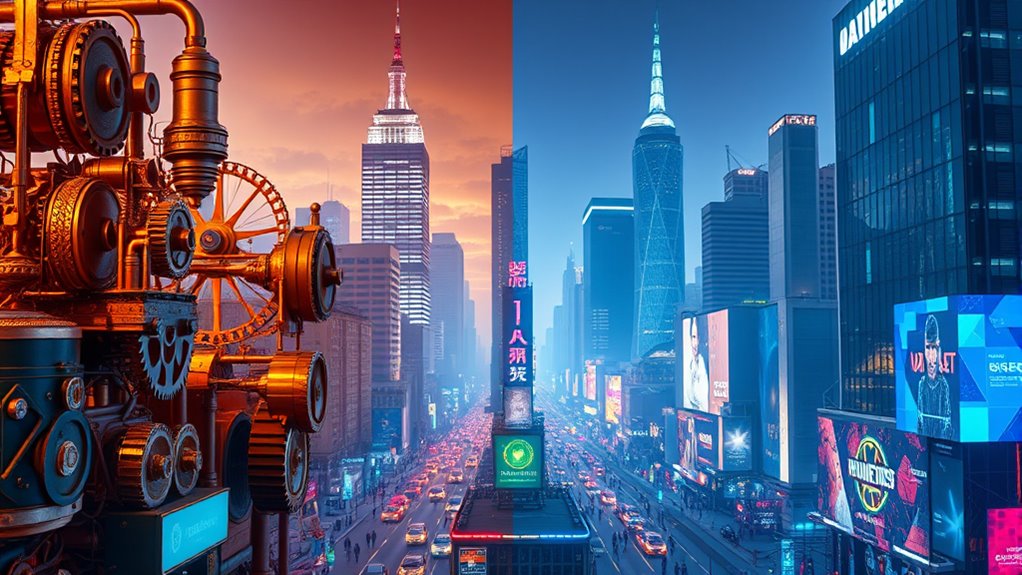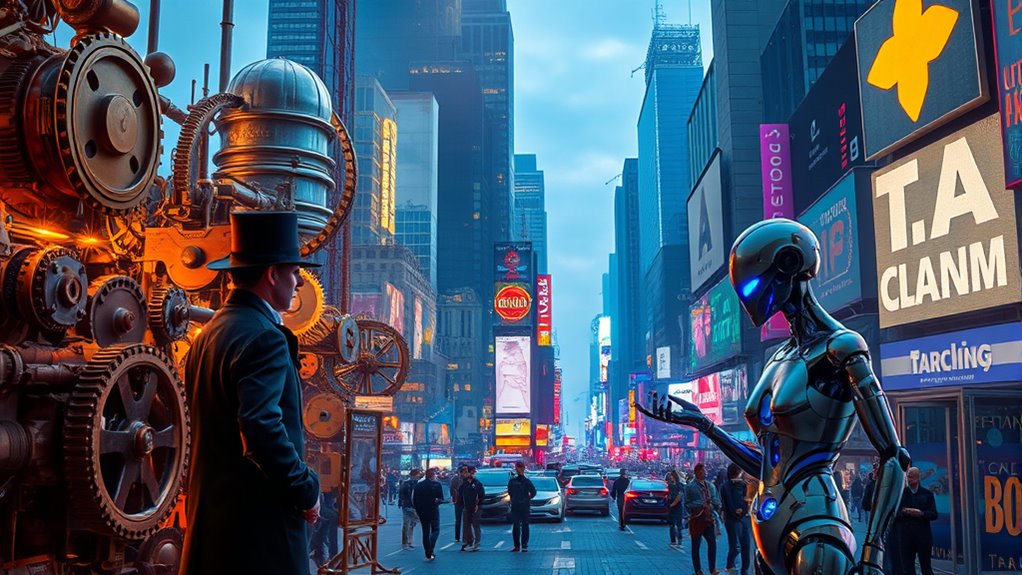Steampunk tech is all about handcrafted machinery, with gears, brass, and steam-powered designs that evoke a nostalgic, tactile feel. In contrast, cyberpunk showcases sleek digital futures, neon-lit cityscapes, holograms, and advanced electronics that emphasize speed and connectivity. Your view of technology either taps into a warm, artisanal past or a fast-paced, digital chaos. If you’re curious about how these worlds clash and complement each other, there’s more to uncover.
Key Takeaways
- Steampunk features handcrafted, intricate mechanical devices inspired by Victorian-era technology, emphasizing tactile craftsmanship and ornate design.
- Cyberpunk showcases sleek, high-tech electronics, digital interfaces, and cybernetics, reflecting rapid technological advancement and digital connectivity.
- Steampunk’s aesthetic is warm, nostalgic, and tactile, contrasting with cyberpunk’s vibrant, neon-lit, impersonal digital landscapes.
- The philosophies differ: steampunk celebrates craftsmanship and mechanical ingenuity; cyberpunk focuses on information flow and digital dominance.
- Societal visions vary: steampunk envisions a past-inspired, artisanal future; cyberpunk depicts a dystopian, corporate-controlled digital world.

Have you ever wondered how steampunk and cyberpunk technologies differ in their visions of the future? It’s a fascinating contrast that reflects two distinct worlds—one rooted in the past, the other in a speculative digital future. Steampunk draws its inspiration from Victorian machinery, blending the elegance and craftsmanship of the 19th century with imaginative technology. Imagine intricate gears, steam-powered engines, and brass fittings that bring these machines to life. The aesthetic is warm, tactile, and nostalgic, emphasizing handcrafted mechanical devices that seem to pulse with life. Victorian machinery isn’t just functional; it’s a symbol of innovation fused with artistry. It’s about reimagining the Industrial Revolution, where clockwork and steam drive society forward. This creates a universe where technology isn’t cold or impersonal but rich with ornate detail and tangible craftsmanship. As you explore steampunk worlds, you notice how each gadget exudes a sense of history and craftsmanship, making technology feel more personal and accessible.
In stark contrast, cyberpunk envisions a future defined by neon aesthetics and digital sophistication. Think of sprawling cityscapes illuminated by vibrant, glowing signs, holographic advertisements, and a relentless stream of data. Here, technology is sleek, fast, and often anonymous. Cyberpunk envisions a world where information flows seamlessly, but at the cost of privacy and humanity. The neon lights symbolize the high-tech, urban jungle—bright, loud, and almost overwhelming. The focus is on advanced electronics, cybernetics, and virtual realities that blur the line between human and machine. This future feels impersonal and commodified, with a digital landscape that’s constantly in flux. When you look at cyberpunk settings, you see a world driven by innovation but also marked by social disparity, corporate control, and a sense of dystopia masked behind shiny screens and towering skyscrapers. The aesthetic is sharp, modern, and often gritty, emphasizing speed and connectivity over craftsmanship.
Ultimately, the difference between these visions lies in their core philosophies. Steampunk celebrates a nostalgic reverence for craftsmanship and the mechanical, emphasizing a tactile connection to technology. Cyberpunk, on the other hand, embraces digital chaos, sleekness, and the power of information—highlighted by neon aesthetics that symbolize the dazzling yet dystopian allure of the future. Both offer compelling worlds, but they represent vastly different ideals: one rooted in analog dreams, the other in digital futures.
Frequently Asked Questions
How Do Steampunk and Cyberpunk Influence Contemporary Fashion Trends?
You see how steampunk and cyberpunk influence contemporary fashion trends by blending Victorian aesthetics with futuristic fabrics. Steampunk inspires you to incorporate vintage-inspired accessories, leather, and brass details, creating a nostalgic yet innovative look. Cyberpunk pushes you toward sleek, high-tech styles with neon accents and metallic materials. Both styles encourage mixing old and new, shaping fashion into bold statements that reflect a fascination with both the past and the future.
What Are the Core Philosophical Differences Between Steampunk and Cyberpunk Worlds?
You see that steampunk world embraces technological optimism, celebrating Victorian innovation and craftsmanship, often envisioning a hopeful future through retro-futuristic lenses. In contrast, cyberpunk offers a dystopian critique, highlighting societal decay and corporate control in a digital age. These worlds differ fundamentally: one exudes nostalgia and optimism, while the other warns of technology’s potential to deepen inequality and chaos.
Which Genres Inspire Steampunk and Cyberpunk Technology Development?
You might think Victorian innovation fuels steampunk, drawing from brass gears and steam engines, while cyberpunk gets its sparks from digital dystopias and neon-lit futures. In reality, both genres borrow wildly—steampunk from Victorian ingenuity and imagination, cyberpunk from gritty tech and cybernetic dreams. If you believe these genres shape tech development, just remember: one’s about clockwork and corsets, the other, hacking and high-tech chaos. Both inspire tomorrow’s wired worlds.
How Do Steampunk and Cyberpunk Cultures Impact Modern Art Movements?
You see how steampunk and cyberpunk cultures shape modern art movements by inspiring alternative art and unique aesthetic movements. Steampunk’s vintage, industrial look influences designs that blend historical elements with modern creativity. Meanwhile, cyberpunk’s futuristic, digital vibe fosters innovative digital art and cyber-inspired aesthetics. Both cultures challenge conventional styles, encouraging artists to explore new themes and techniques, ultimately enriching the diversity and depth of contemporary art scenes.
Are There Any Notable Collaborations Between Steampunk and Cyberpunk Creators?
Yes, there are notable collaborations between steampunk and cyberpunk creators, often through crossover media and collaborative projects. You might find artists blending Victorian aesthetics with futuristic cyber elements or writers combining dystopian themes with retro-futuristic designs. These projects create unique visual and narrative styles that appeal to fans of both genres, pushing boundaries and inspiring new hybrid concepts within modern art and pop culture.
Conclusion
As you navigate between steampunk’s brass gears and cyberpunk’s neon-lit shadows, you realize each offers a different dream—one of nostalgic craftsmanship, the other of digital revolution. Think of steampunk as a vintage clockwork universe ticking with analog passion, while cyberpunk’s future pulses like a neon heartbeat. Whichever world pulls at your imagination, remember: both are vivid tapestries woven from your own desires for innovation and nostalgia, inviting you to choose your adventure in this sprawling tech landscape.








